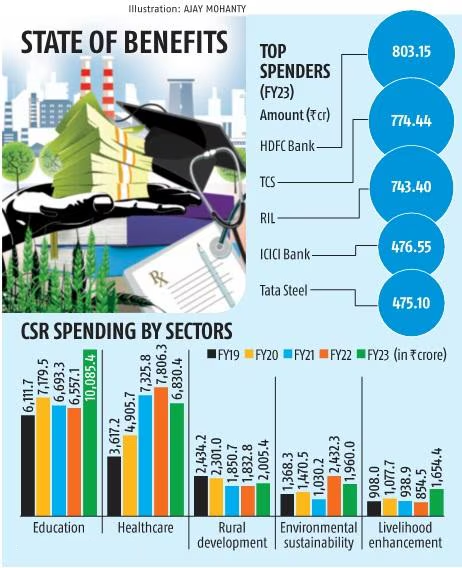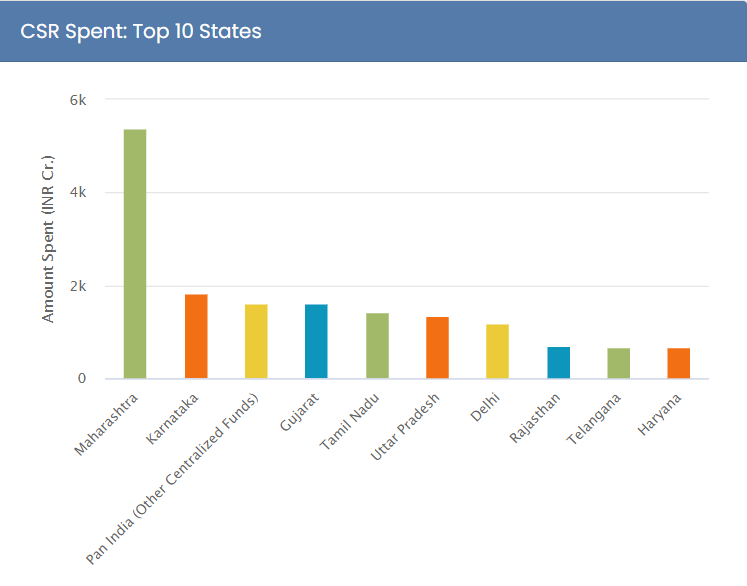CSR Expenditure 2023 | 14 Aug 2024
For Prelims: Corporate Social Responsibility, Amendments to the Companies Act, National Company Law Appellate Tribunal (NCLAT), Transforming Indian Education: Towards Long-Term Vision
For Mains: Social impact of CSR spending, Issues related to CSR expenditure
Why in News?
Recently, government data revealed that education received the highest share of corporate social responsibility (CSR) expenditure in FY23, with Rs 10,085 crore allocated, this ignited debate about uneven spending of CSR in a few sectors and regions.
What are the Recent Developments in CSR Expenditure?
- Overview:
- Total CSR expenditure increased from Rs 26,579.78 crore in FY22 to Rs 29,986.92 crore in FY23. The number of CSR projects rose from 44,425 to 51,966.
- Companies outside the public sector contributed 84% of the total CSR spend.
- Sector Wise Expenditure:
-
Education accounted for one-third of the CSR spend in FY23.
- CSR spending on vocational skills rose slightly to Rs1,164 crore in FY23 from Rs 1,033 crore the previous year.
- Technology incubators got the lowest amount, with only Rs 1 crore in FY23 compared to Rs 8.6 crore in the previous year
- Health, rural development, environmental sustainability, and livelihood enhancement also received significant CSR funds.
- CSR spending on animal welfare surged from Rs 17 crore in FY15 to over Rs 315 crore in FY23.
- CSR expenditure under the Prime Minister Relief Fund dropped to Rs 815.85 crore in FY23, down from Rs 1,698 crore in FY21 and Rs 1,215 crore in FY22.
- Contribution to disaster management fell the most (77%), followed by that on slum development (75%).
-
- Region Wise Expenditure:
- Maharashtra, Karnataka, Gujarat received the most CSR spends while North East states, Lakshadweep and Leh and Ladakh received the least CSR spendings.
What is CSR?
- About:
- Corporate Social Responsibility (CSR) in general can be referred to as a corporate initiative to assess and take responsibility for the company's effects on the environment and impact on social welfare.
- It is a self-regulating business model that helps a company to be socially accountable. By practising corporate social responsibility, companies can be conscious of the impact they are having on economic, social, and environmental factors.
- India is the first country to mandate CSR spending under clause 135 of the Companies Act, 2013, with a framework for identifying potential CSR activities.
- Unlike India, most countries have voluntary CSR frameworks. Norway and Sweden, which have moved to mandatory CSR provisions, began with voluntary models.
- Applicability:
- CSR provisions apply to companies meeting any of the following criteria in the preceding financial year.
- Net worth over Rs. 500 crore
- Turnover over Rs. 1000 crore
- Net profit over Rs. 5 crore.
- Such companies must spend at least 2% of their average net profits from the last three financial years on CSR activities, or if newly incorporated, based on the average net profits from preceding financial years.
- CSR provisions apply to companies meeting any of the following criteria in the preceding financial year.
-
Types of Corporate Social Initiatives:
- Corporate Philanthropy: Donations to charity via a corporate foundation.
- Community Volunteering: Company-organised volunteer activities.
- Socially-responsible Business practices: Producing ethical products.
- Cause Promotions and Activism: Company-funded advocacy campaigns.
- Cause-based Marketing: Donations to charity based on sales.
- Corporate Social Marketing: Company-funded behaviour-change campaigns
- Eligible Sectors:
-
CSR activities encompass a range of initiatives, including eradicating hunger and poverty, promoting education and gender equality, combating diseases like HIV/AIDS, ensuring environmental sustainability, and contributing to government relief funds (Like PM CARES and PM Relief Fund) for socio-economic development and the welfare of disadvantaged groups
-
What are the Issues Pertaining to CSR Compliance?
- Geographical Disparity in CSR Spending: Spending is concentrated in industrial states like Maharashtra (5375cr.), Gujarat, Karnataka, and Tamil Nadu, while North Eastern states (Mizoram 6.9 cr) and Lakshadweep, Leh and Ladakh receive comparatively less funding, reflecting a regional imbalance.
- CSR Allocation Trends: MCA data reveals that nearly 75% of CSR funds are concentrated in three sectors: education, health (including sanitation and water), and rural poverty.
- Sectors related to Livelihood enhancement (Rs 1,654 cr) have very less spending.
- PSU vs Non-PSU Spending: Non-PSUs contribute 84% of total CSR spending, while PSUs account for the remaining 16%, highlighting a significant difference in CSR expenditure between the two sectors.
- Strategic Misalignment in CSR: Many companies have merged sustainability with business strategies, prioritising profit margins over genuine social impact, thus undermining the true purpose of CSR.
- Finding Right Partners: Despite growing awareness about the significance of CSR compliance, the challenges remain in identifying the right partners as well as in selecting projects that are long-term impactful, scalable, and are self-sustaining.
- Issues of Transparency: There is an expression by the companies that there exists lack of transparency on the part of the local implementing agencies as they do not make adequate efforts to disclose information on their programs, audit issues, impact assessment and utilisation of funds.
What are the Ways to Enhance the Effectiveness of CSR Expenditure?
- Enhancing CSR Engagement and Oversight: Aligning CSR with local government programs like the ADP(Aspirational Districts Programme) can boost community participation and engagement, while the government should ensure effective CSR implementation, and leverage AI for better oversight.
- NGOs can work along with companies in remote and rural areas to ensure successful implementation of CSR activities.
- Address Sectoral and Geographical Disparity: Need to Invest in higher education and high impact technological and environment friendly projects that focus on skill development and livelihood enhancement.
- Develop CSR programs for underserved regions, offer incentives for spending in less-funded areas or make a mandatory provision to address regional disparity in spending, and collaborate with local NGOs.
- PSU vs Non-PSU Spending Disparity: Encourage PSUs to increase contributions, implement benchmarking, and promote joint CSR initiatives between PSUs and non-PSUs.
- Company Roles and Governance: Conduct regular reviews, set clear objectives, and update governance roles. Establish new SOPs for fund utilisation, impact assessments, and detailed checklists.
Conclusion
To maximize the impact of CSR, companies must move beyond mere compliance and embrace strategic alignment with local government programs, address sectoral and regional disparities, and ensure transparency and accountability.
By fostering stronger collaborations between PSUs and non-PSUs and investing in innovative, scalable projects, CSR can drive sustainable social change and contribute to India’s long-term socio-economic development.
|
Drishti Mains Question: Q. Describe how Corporate Social Responsibility can become a financing arm to address the socio-economic issues of society? |


